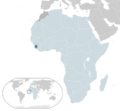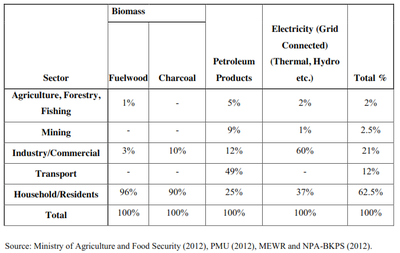Difference between revisions of "Sierra Leone Energy Situation"
***** (***** | *****) |
***** (***** | *****) m |
||
| Line 1: | Line 1: | ||
| + | |||
{{CES Country | {{CES Country | ||
|CES Country Name=Sierra Leone | |CES Country Name=Sierra Leone | ||
| Line 7: | Line 8: | ||
= Introduction = | = Introduction = | ||
| − | |||
| − | |||
= Energy Situation = | = Energy Situation = | ||
| − | |||
== Overall Energy Statistics == | == Overall Energy Statistics == | ||
| Line 20: | Line 18: | ||
*13% Petroleum products (mainly for transport, lighting and private energy generation)<ul style="list-style-type:circle;"> | *13% Petroleum products (mainly for transport, lighting and private energy generation)<ul style="list-style-type:circle;"> | ||
| + | </ul> | ||
| + | </ul> | ||
| + | <ul style="margin-left: 40px;"> | ||
<li>All petroleum is imported</li> | <li>All petroleum is imported</li> | ||
</ul> | </ul> | ||
| − | |||
| − | |||
| − | |||
| − | |||
| − | |||
| − | |||
| + | *Grid connected energy accounts for the remaining energy | ||
| + | *Most of the energy is used in households<br/> <ref>UNDP, 2012. National Energy Profile pf Sierra Leone, s.l.: UNDP.</ref><ref>Taylor, S. & Buya-Kamara, Z., 2013. Sierra Leone Energy Africa Compact, Freetown: Energy Africa.</ref><br/>[[File:Structure on Energy Consumption in 2011.png|left|400px|alt=Structure on Energy Consumption in 2011.png]]<br/><ref>UNDP, 2012. National Energy Profile pf Sierra Leone, s.l.: UNDP.</ref><br/> | ||
== Electricity Generation == | == Electricity Generation == | ||
| − | *81,000 kW installed capacity (2012) | + | **81,000 kW installed capacity (2012) |
| − | *33.3% Fossile Fuels (44 MW from Oil) | + | **33.3% Fossile Fuels (44 MW from Oil) |
| − | *66.7% Hydro Power (56 MW) | + | **66.7% Hydro Power (56 MW) |
| − | *Zero Imports, Zero Exports | + | **Zero Imports, Zero Exports |
| − | *Only 12% of the population has access to electricity (in rural areas only around 2%) | + | **Only 12% of the population has access to electricity (in rural areas only around 2%) |
| − | <ref>U.S. Energy Information Administration, 2015. International Energy Statistics. [Online] | + | <ref>U.S. Energy Information Administration, 2015. International Energy Statistics. [Online] fckLRAvailable at: http://sierraleone.opendataforafrica.org/search?query=energyfckLR[Accessed 17 June 2016].</ref><ref>UNDP, 2012. National Energy Profile pf Sierra Leone, s.l.: UNDP.</ref><br/> |
| − | |||
| − | [Accessed 17 June 2016].</ref><ref>UNDP, 2012. National Energy Profile pf Sierra Leone, s.l.: UNDP.</ref><br/> | ||
| + | <br/> | ||
= Renewable Energy = | = Renewable Energy = | ||
| − | |||
= Fossil Fuel = | = Fossil Fuel = | ||
| − | |||
= Key Problems of the Energy Sector = | = Key Problems of the Energy Sector = | ||
| − | |||
= Policy Framework, Laws and Regulations = | = Policy Framework, Laws and Regulations = | ||
| − | |||
= Institutional Set up in the Energy Sector = | = Institutional Set up in the Energy Sector = | ||
| − | |||
= Further Information = | = Further Information = | ||
| − | |||
= References = | = References = | ||
| + | [[Category:Africa]] | ||
[[Category:Sierra_Leone]] | [[Category:Sierra_Leone]] | ||
| − | |||
Revision as of 23:22, 17 June 2016
Capital:
Freetown
Region:
Coordinates:
8.4844° N, 13.2344° W
Total Area (km²): It includes a country's total area, including areas under inland bodies of water and some coastal waterways.
72,300
Population: It is based on the de facto definition of population, which counts all residents regardless of legal status or citizenship--except for refugees not permanently settled in the country of asylum, who are generally considered part of the population of their country of origin.
8,605,718 (2022)
Rural Population (% of total population): It refers to people living in rural areas as defined by national statistical offices. It is calculated as the difference between total population and urban population.
56 (2022)
GDP (current US$): It is the sum of gross value added by all resident producers in the economy plus any product taxes and minus any subsidies not included in the value of the products. It is calculated without making deductions for depreciation of fabricated assets or for depletion and degradation of natural resources.
4,094,563,859 (2022)
GDP Per Capita (current US$): It is gross domestic product divided by midyear population
475.80 (2022)
Access to Electricity (% of population): It is the percentage of population with access to electricity.
27.49 (2021)
Energy Imports Net (% of energy use): It is estimated as energy use less production, both measured in oil equivalents. A negative value indicates that the country is a net exporter. Energy use refers to use of primary energy before transformation to other end-use fuels, which is equal to indigenous production plus imports and stock changes, minus exports and fuels supplied to ships and aircraft engaged in international transport.
no data
Fossil Fuel Energy Consumption (% of total): It comprises coal, oil, petroleum, and natural gas products.
no data
Introduction
Energy Situation
Overall Energy Statistics
- 80% Biomass (mainly for cooking)
- Wood Fuel
- Charcoal
- 13% Petroleum products (mainly for transport, lighting and private energy generation)
- All petroleum is imported
- Grid connected energy accounts for the remaining energy
- Most of the energy is used in households
[1][2]
[3]
Electricity Generation
- 81,000 kW installed capacity (2012)
- 33.3% Fossile Fuels (44 MW from Oil)
- 66.7% Hydro Power (56 MW)
- Zero Imports, Zero Exports
- Only 12% of the population has access to electricity (in rural areas only around 2%)
Renewable Energy
Fossil Fuel
Key Problems of the Energy Sector
Policy Framework, Laws and Regulations
Institutional Set up in the Energy Sector
Further Information
References
- ↑ UNDP, 2012. National Energy Profile pf Sierra Leone, s.l.: UNDP.
- ↑ Taylor, S. & Buya-Kamara, Z., 2013. Sierra Leone Energy Africa Compact, Freetown: Energy Africa.
- ↑ UNDP, 2012. National Energy Profile pf Sierra Leone, s.l.: UNDP.
- ↑ U.S. Energy Information Administration, 2015. International Energy Statistics. [Online] fckLRAvailable at: http://sierraleone.opendataforafrica.org/search?query=energyfckLR[Accessed 17 June 2016].
- ↑ UNDP, 2012. National Energy Profile pf Sierra Leone, s.l.: UNDP.






















